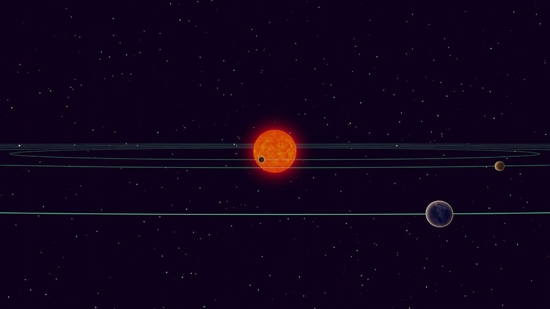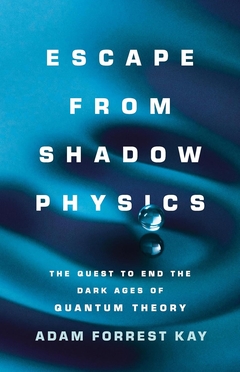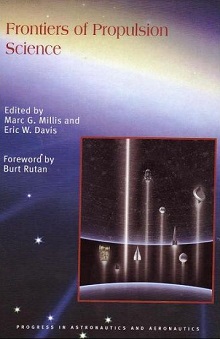You would think that the orbits of planets would align closely with the spin of their star, since they emerged from the same primordial disk. Many planets do just that, and in our own system, the orbits of the planets are aligned within 6 degrees of the Sun’s rotation. But the numerous cases of star-planet orbital misalignment around other stars cause us to question whether these systems formed out of alignment or were influenced by later perturbations. A massive companion in a wide orbit could do the trick, and other mechanisms to tilt the orbital or spin axes are discussed in the literature.
To examine the question, the Rossiter-McLaughlin effect comes into play. Discovered by studying binary stars, the effect is named after the two University of Michigan graduate students who figured it out back in the 1920s. They realized that as a star rotates, part of it seems to be coming toward the observer, creating a blueshift, while the other side seems to be moving away, producing a redshift. As a transiting planet blocks part of the background stellar disk, it creates an observable effect in the redshift that flags the direction of the planet’s rotation.
Thus we tease out yet further information about planets we cannot directly see. Now a team of astronomers using the Subaru Telescope has been able to deploy the Rossiter-McLaughlin effect to measure the obliquity, or spin-orbit angle, of three of the planets in the intriguing TRAPPIST-1 system. Here we have an M-dwarf orbited by seven small planets, evidently rocky, with three in or near the habitable zone as defined by the possibility of liquid water on the surface.
What we learn is that the three transiting planets the team observed on August 31, 2018 (two of them near the habitable zone) have an obliquity that is near zero. This marks the first time that stellar obliquity has been measured in a system around a very low-mass star like TRAPPIST-1. Led by Teruyuki Hirano (Tokyo Institute of Technology), the astronomers used the InfraRed Doppler (IRD) spectrograph, a new instrument on the Subaru Telescope, to make the measurement. Says Hirano:
“The data suggest alignment of the stellar spin with the planetary orbital axes, but the precision of the measurements was not good enough to completely rule out a small spin-orbit misalignment. Nonetheless, this is the first detection of the effect with Earth-like planets and more work will better characterize this remarkable exoplanet system.”

Image: Artist’s impression of the TRAPPIST-1 exoplanet system.(Credit: NAOJ).
Learning about spin-orbit misalignment (or the lack of same) is useful as we try to understand how planets around low mass stars evolve. The lack of larger worlds around this star, or the presence of a nearby star, means that the planetary orbits here are probably located close to where the planets first formed, so the orbits offer a window into the early days of the system. Rossiter-McLaughlin analyses have hitherto been restricted to planets of at least Neptune mass, so we’re pushing into new territory as we take advantage of IRD’s high spectral resolution.
Assuming the orbits of the TRAPPIST-1 system are coplanar, the authors offer their take on the system’s evolution:
Our result supports the idea that the known planets in the TRAPPIST-1 system achieved their compact configuration through convergent migration, and did not experience any substantial misaligning torques from processes such as planet-planet scatterings or long-term gravitational perturbations from a massive outer companion on an inclined orbit. It is unlikely that any primordial obliquity has been erased by tidal realignment between the star and these low-mass planets.
And on that assumption of a coplanar system, the authors add that they were unable to test it by measuring the mutual inclinations between the planets:
The mutual inclinations might be measurable in the future using repeated observations of Doppler transits to give a higher S/N. The mutual inclination between two planetary orbits might also be measured by observing the photometric effect of a planet-planet eclipse during a double transit event (Hirano et al. 2012). This would be another important clue to understand the architecture and dynamical history of the TRAPPIST-1 system.
No equivalent studies have been performed on a star this small, but the window is clearly opening on methods for studying the orbital architectures of such planetary systems.
The paper is Hirano et al., “Evidence for Spin-Orbit Alignment in the TRAPPIST-1 System,” Astrophysical Journal Letters Vol. 890, No. 2 (25 February 2020). Abstract.



It is interesting that with these Lilliput solar systems, that they are such a finely tuned clockworks. Are such systems common in the red dwarfs or as we go up the stars from M dwarfs to O dwarf giants does chaos play a wilder role. It seems the effects of passing stars, rough planets and large long period gas giants would add a chaotic factor as the stars and systems become larger. The shorter lifetime and excess matter around larger stars would seem to point towards this problem.
One point in the very close planets to many stars is the precession caused by the massive stars gravity well, this should be showing up in errors in the transit timing. Could this give us a better precision on the stellar mass?
Yes this system really is like a clockwork – compared to some of the nearly chaotic systems that also have been found.
The text mention “convergent migration” for this and I find that quite plausible.
And yes, I think the stellar mass could be very well calculated for Trappist since the planet interaction could be used to refine the planet masses first and then apply that on the star.
But it still would require quite a study since the star is pulled around a lot by these quickly orbiting worlds and the interactions are complex.
It reminds of Jupiter and it’s Moons. I don’t see why there has to be a migration to give a zero obliquity. There is tidal locking and the much larger star to keep the orbits along the plane of the equator of the star which is how a proto planetary disk forms. The angular momentum of the star is transferred to the planets. It’s not a large system so there has not been a lot of angular momentum transferred to the exoplanets so no migration is needed? Trappist one still has a fast rotation.
Alas:
https://manyworlds.space/2017/11/22/can-you-overwater-a-planet/amp/
Does that Alien Oceans book mention TRAPPIST-1?
Hi Paul
“A massive companion in a wide orbit could do the trick” isn’t this the proposed outer ice giant ie Planet 9 that has caused the sun to tilt 6degrees from the plane of the planets rotation.
“as we try to understand how stars around low mass stars evolve” I’m sure you meant to say Planets here.
A very interesting read and now to catch up on your other posts
Thanks Laintal
Yes, I must have made a typo there. I’ll go fix it right now. Thanks!